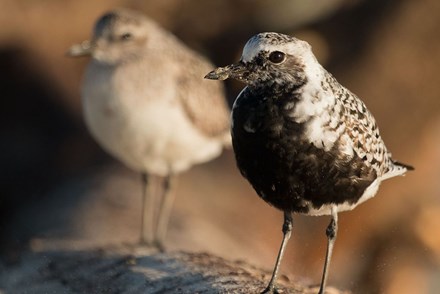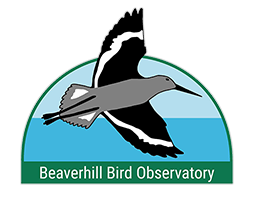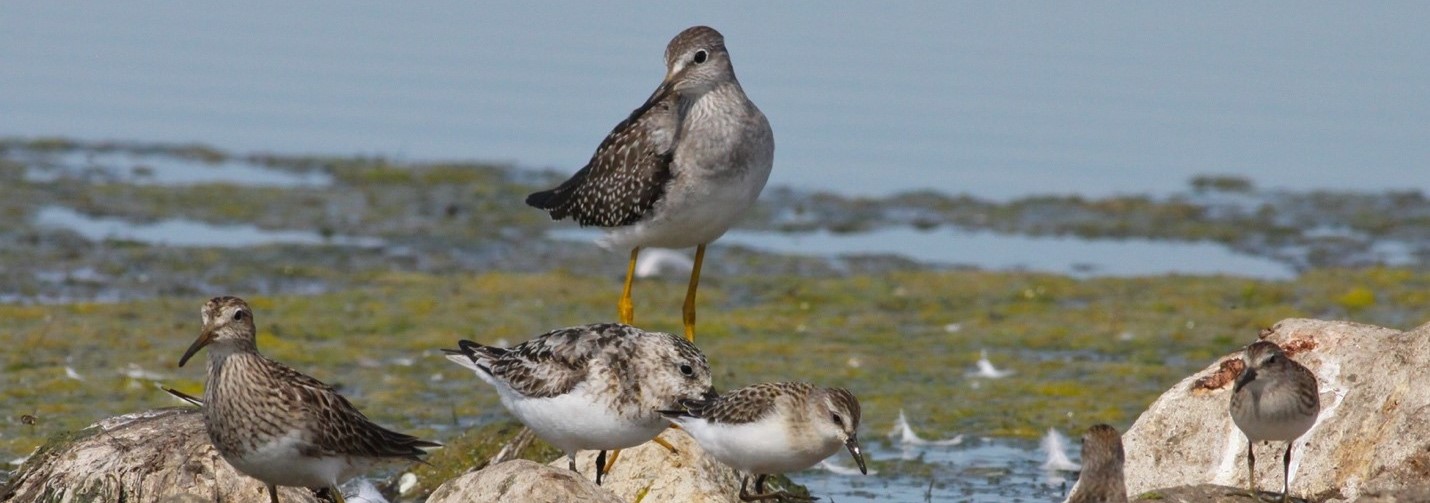Impact of Climate Change on Shorebirds
Tuesday, January 7, 2020As climate change intensifies, we will experience increased frequency and intensity of flooding and drought events, more severe forest fires and hurricanes, and sea level rise. While these extremes will severely impact humans, they will also impact the natural world. In this blog, we will look at the impacts of climate change on the avian world by focusing on shorebirds.
Shorebirds 101
Shorebirds comprise a diverse group of species including Killdeer, Piping Plover, Whimbrel, Marbled Godwits, and Red-necked Phalarope. One feature common to all the shorebirds, as the name suggests, is their reliance on shallow shores of lakes and waterbodies. Wading their way through shallow water along the shores with their relatively long legs, these birds eat aquatic insects. Each year, Alberta host 20 million shorebird migrants. While many species migrate each year to nest in the arctic, some 20+ species nest regularly in Alberta, including Killdeer and American Avocet. Shorebirds provide many important cultural and environmental services as they are an integral part of many food chains, wetland ecosystems, and provide cultural value for the birding communities. However, this rich biodiversity has come under severe threat. Since 1970s, the total population of shorebirds have declined nearly 40%. Habitat loss and degradation, unsustainable agricultural practices, urban development, and climate change are the main threats responsible for this decline.
Impact of Climate Change on Shorebirds
 Globally, millions of shorebirds migrate thousands of kilometers each year to nest and raise their young in the arctic. This journey is particularly challenging due to environmental extremes, like hurricanes, that the birds have to endure, and climate change is making migration more challenging by amplifying these extremes. Yet, enduring these challenging conditions is worth the risk to shorebirds in order to move between the arctic breeding grounds and the tropical wintering grounds, which are favoured for their safety feature,
Globally, millions of shorebirds migrate thousands of kilometers each year to nest and raise their young in the arctic. This journey is particularly challenging due to environmental extremes, like hurricanes, that the birds have to endure, and climate change is making migration more challenging by amplifying these extremes. Yet, enduring these challenging conditions is worth the risk to shorebirds in order to move between the arctic breeding grounds and the tropical wintering grounds, which are favoured for their safety feature,
i.e., low risk of predation. However, climate change continues to impact shorebirds by now increasing that low predation risk.
Shorebirds share their arctic home with many other animals including rodents like lemmings and predators like arctic foxes. Lemmings survive the cold winters by eating mosses under the snow which grow abundantly in the arctic. Climate change, however, is causing thawing-freezing events, which traps that moss under a layer of ice, limiting the lemmings’ food supply, causing many of them to die of starvation. As a result, when lemming populations decline, predators like arctic foxes and jaegers, switch to preying on shorebirds instead, hunting their eggs and eating their young. In some places, scientists have recorded a two to three-fold increase in daily nest predation in the last 70 years.
Down south in the Canadian prairies, millions of shallow ponds called prairie potholes are prone to seasonal variability. Some of these potholes dry up during the summer months, while others persist throughout the year. Another impact of climate change is the increased frequency of droughts, which results in more potholes drying up during the summer, causing a severe loss of habitat for shorebirds during both migration and breeding season. Furthermore, shorebirds using coastal wintering grounds both in North America and South America are expected to lose large areas of their habitat due to rising sea levels.
What Can We Do?
There are number of things we can do to help our feathery friends. We can support organizations, like Ducks Unlimited, that conserve important bird habitats. If you are a land owner with wetlands, you can avoid draining the wetlands and accommodating beavers if they are present. We can also reduce our carbon footprint, helping tackle climate change. Our food industry is one of highest greenhouse gas emitters among all other sectors. Meat production, for example, requires intense use of fossil fuels to cultivate the land, to produce and apply chemicals (fertilizers/pesticides), and in some locations to irrigate with water, for the production of animal feeds. This produces high amounts of carbon emissions. Therefore, eating meat, especially beef raised in feed lots, contributes significantly toward climate change. Eating one kilogram of beef produces the equivalent carbon emissions of driving a Honda Civic for 176 km. While in comparison, eating one kilogram of lentils only causes emissions equivalent of driving it 6 km. Therefore, by reducing your meat consumption by eating lower in the food chain, i.e., more vegetables and legumes, you can greatly reduce your carbon emissions to help reduce climate change and help our feathery friends! Eating wild game and fish that is harvested sustainably from natural environments lowers your carbon footprint even more and helps to protect wildlife habitats.
Picture Credit
dfaulder, source five species of shorebirds, accessed December 30, 2019, retrieved from https://commons.wikimedia.org/wiki/File:Five_species_of_shorebirds_(6048447238).jpg
Black-bellied plover by USFWS - Pacific Region, bbpl_moplo. 3 April 2016. https://commons.wikimedia.org/wiki/File:Black-bellied_plover_(Pluvialis_squatarola)_(26123412532).jpg
Additional Readings
https://www.ducks.ca/places/alberta/
http://www.hww.ca/en/wildlife/birds/shorebirds.html
http://naturealberta.ca/wpcontent/uploads/2019/11/2019_NatureAlberta_ShorebirdsChecklist_web.pdf
https://www.ducks.ca/news/national/canadas-birds-are-warning-us-about-the-state-of-ournatural-world/
http://www.natureconservancy.ca/en/where-we-work/manitoba/news/shorebird-populations.html
https://shorebirds.pwnet.org/migration/importance.htm
http://www.gbrmpa.gov.au/__data/assets/pdf_file/0019/21745/gbrmpa-VA-Shorebirds-11-7- 12.pdf
https://science.sciencemag.org/content/362/6415/680
https://royalsocietypublishing.org/doi/full/10.1098/rspb.2012.1490
https://www.ncbi.nlm.nih.gov/pmc/articles/PMC4077800/
Rolf A. Ims, John-Andre Henden, and Siw T. Killengreen, retrieved on December 31, 2019, Collapsing population cycles, Trends in Ecology and Evolution, Vol. 23, No.2 http://re.indiaenvironmentportal.org.in/files/Linking%20climate%20change%20to%20lemming %20cycles.pdf
https://besjournals.onlinelibrary.wiley.com/doi/pdf/10.1111/j.1365-2656.2005.01031.x
https://www.audubon.org/news/the-arctic-no-longer-safe-haven-breeding-shorebirds#
https://journals.plos.org/plosone/article/file?id=10.1371/journal.pone.0108899&type=printable
http://www.wetlandpolicy.ca/wetlands-climate-change
https://www.audubon.org/news/shorebirds-experience-dismal-breeding-season-due-quirkclimate-change
https://www.ducks.ca/places/prairie-pothole-region/
https://web.stanford.edu/group/stanfordbirds/text/essays/Shorebird_Migration.html
https://www.allaboutbirds.org/news/fantastic-journeys-shorebirds-are-next-level-athletes/
https://www.nrcan.gc.ca/sites/www.nrcan.gc.ca/files/earthsciences/pdf/assess/2007/pdf/ch7_e.pd f
https://www.cbc.ca/news/technology/food-climate-change-carbon-footprint-1.4930062
Blog Posts
- What is Climate Change
- Drought: What Can We Do?
- Migration and Climate Change; a Complicated Relationship (Part 1)
- Migration and Climate Change; a Complicated Relationship (Part 2)
- Climate Change and Birds’ Resources
- Ladder to Extinction
- Arctic Warming and Ecosystem Impacts
- Climate Change Connection to Mountain Pine Beetle
- Tackling Climate Change Denialism
- Impact of Climate Change on Bluebirds
- An Introduction to Climate Change
- Great Decline of Aerial Insectivores
- Role of Oceans in Fighting Climate Change
- Role Of Forests In Fighting Climate Change
- Impact of Climate Change on Shorebirds
- Impact of Hurricanes and Climate Change on Birds
- An Introduction to Climate Change.
- Impact of Forest Fires, and Climate Change on the Nature
- Impacts of Climate Change on Owls
- Impacts of Climate Change on Birds of Prey
- Whitebark Pine and Clark's Nutcracker
- COVID 19 & The Environment
- Impact of Global Warming on Bird Anatomy and Colour Polymorphism
- Climate Change & West Nile Virus
- All Posts

